![]()
| VA to Lima, Peru | |
|
Although we would be gone for nine days,
we were still able to pack in our small bag that fits in the
overhead bin on the airplane and one book bag each. Traveling light and
not having to check any luggage makes traveling so much easier. We were going to be in a different hotel every night except for
when we arrived in the Amazon - then, we would be in Explorama Lodge for two
nights in a row.
After driving to Charlotte, NC, flying to Atlanta, then on to Lima, we arrived well after midnight. Our flight to Cuzco was in the early morning - we got about five hours of sleep and were off again. |
|
|
|
|
|
To Cuzco & The Upper Ruins The city of Cuzco (also spelled Cusco) is located over 700 miles southeast of Lima - about an hour flight over the Andes. At an altitude of almost 11,500 feet, many people find that they get headaches or altitude sickness. Fortunately, we didn't have any troubles except for getting a bit winded on long brisk walks. After dropping off our bags at the
Libertador Hotel, we found a little shop that sold cold Diet Coke. Ahh!
Amy hadn't had a soda for days - it is her version of coffee in the
morning. However, she wouldn't recommend drinking much of it at these altitudes. As soon
as the first little sip passed her lips, her cheeks puffed out like a
chipmunk's. Those teeny bubbles became major foam. In the afternoon we went on a guided tour of Cuzco and the Inca ruins above the city. |
|
 |
 |
| Cuzco's city square & main church. All around the square were small, second story restaurants that served wonderful meals. Bob got a dinner of skewered alpaca with other mixed meats. We both thought the alpaca, of course, tasted like chicken, but sort of looked like tender pork. | Tambomachay (the highest ruin above Cuzco) was built as a water temple for religious & ritual cleansing & bathing. It has an underground spring that cascades down a series of walls and pools. The stonework was done in the style of the nobles and priests who most likely used these springs. |
 |
 |
| Sacsayhuaman (sounds like sexy woman) is a
Quechua Inca word, meaning "speckled falcon." Historians believe
that the city of Cusco was originally built in
the form of a puma whose head was the hill of Sacsayhuaman. Three levels to the
main walls remain - each built in big zigzags for
defense. It was started in the early 1400s and took over 100 years to complete.
see http://www.cuscounlimited.com/cusco-peru/citytour.asp |
Bob and K&K are standing on the road to the ruins above Cuzco. The view was incredible. |
|
|
|
| Train to Aqua Calientes, the city at the bottom of Machu Picchu | |
 |
 |
| Cold morning! High 20's and an unheated train starting off at 6:00 am for a four hour ride to Aqua Calientes. | K & K are looking at Cuzco. The train had to climb the mountain beside Cuzco to start the trip. It zigzagged back and forth going forward, then backwards, up the mountain till we got over it. |
 |
|
| K & K take a look at the mountains we passed from the windows on the roof of the train. The ride was beautiful - little towns, children waking up in the frost to herd their cows, alpaca, goats, llamas, and all the rest to the fields, with deep ravines with ice cold water spilling over the rocks. | |
|
|
| Machu Picchu & bus ride | |
 The white areas are the dirt road with its hairpin turns from Aqua Calientes to Machu Picchu. It isn't the bus ride, per say, that is scary - it is meeting busses going the other way that terrifies. With barely room to pass, not a single guard rail, motivated drivers delivering their passengers, and hundreds of feet of shear drop offs, the ride up or down is not for the faint of heart. |
 But, the view wass worth it!!! |
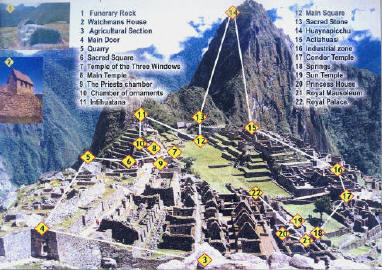 from "Machu Picchu - The complete guide" editoralpiki@hotmail.com |
The Inca people lived by three laws that governed their society: Ama Sua (don't steal), Ama Lluya (don't lie), and Ama Quella (don't be idle). They understood mathematics, astronomy, architecture, engineering, art, agriculture, and other major subjects. Their empire covered almost one and a half million square miles and was ruled by the Supreme Chief. The Incas believed in many gods but the most important one was the Sun God (Inti). Other gods represented the natural elements such as the moon (Quilla - Inti's partner), water, rainbows, the stars, earth, and others. Their empire dates from the early 1400's and effectively ended with a civil war of sorts in the mid 1500's. |
|
Hiram Bingham discovered Machu Picchu on July 24th, 1911 with the help of
a local 12 year old boy. The city covers over 3 square miles and was built
on the top of the mountain for defensive purposes. It has three main
sectors: agricultural (the terraces), urban (living quarters), and the
ceremonial area (Intihuatana).
The entire city has underground aqueducts that feed the mountain waters through the entire city and the terraced areas. They were all planned and built prior to building the structures and houses on top. It is believed that the city supported a permanent population of 300 people and more than 1,000 during religious ceremonies. |
|
 |
 |
|
|
Watchman's or Guardian's House Located at the highest point, the Incas used this house to control people entering the city and to watch over the agricultural terraces. The thatched roof shows how the other houses and huts would have looked in the past. |
The Main Doorway Originally this was the only entrance to Machu Picchu and is built in the classical trapezoidal form. Many believe that this doorway represents birth, or the "doorway to life." The main areas would then represent the body, and the sun stone and temple the head or knowledge center of the city. Amy is in the blue shirt at the doorway. |
|
 |
 |
|
| Temple of
the Sun This tower was dedicated to the major god - the Sun God, Inti. In the center is a large single slab which was probably an altar. The front window aligns with the sun on the winter and summer solstices, directing the light down the center of the stone altar. |
The four of us pose for a picture with the steep mountains that surround Machu Picchu. | |
 |
 |
|
The Rich vs Poor Every society has people who are in the lower class and the upper class. The two walls on either side of Bob and K & K definitively show the difference in building styles for each class. On the left, the stones are evenly chiseled, expertly aligned, and use no mortar to hold them in place. Not even a piece of paper can fit through any area between the stones. On the right is a wall belonging to a building for
the commoners - the workers. The stones are "unfinished," rough in nature.
They are secured with a type of mortar and do not have the same exacting
fit. |
The view from a Huayrana (place to relax) This hut has only three walls. The front is open to the wind and the view. Incas were very connected to and honored nature - huts like these allowed them to relax and enjoy their surroundings. |
 |
|
|
In one of the temples each of the walls had numerous niches built into the
structure. It is believed that these held religious objects. Also,
archeologists have found that when you put your head into to a niche and
chant "ohm," the sound reverberates and resonates over long
distances with an eerie timbre.
While K & K were in the niche, Bob gave it a try - impressive! |
|

 |
|
|
On the left is the major temple called Intihuatana, which at the top has the sacred Incan sun dial (seen
in the photo on the right). It has seventy-eight steps up with terracing
down the other side. The sun dial is carved out of a solid piece of rock -
part of the mountain itself. It was designed to allow the ancients to gauge the seasonal
cycles with great accuracy. This area is considered to be the major temple
zone for the entire site as it directly represents Inti, the Sun God. |
|
 |
 |
|
The Incas built hundreds of miles of trails between
cities and sacred sites. The red circle surrounds the outpost and ruins
where Machu Picchu can be first seen from the Inca trail - a four day
hike starting from the city of Aqua Calientes. |
One of the local beasties is the Vizcacha. It is sort of a cross between a rabbit and a really big rat. This little guy was happily blending into the background and taking a nap in the warm winter sun. |
 |
 |
|
Huayna Picchu (meaning "young mountain") At the base of the mountain are two buildings which one passes between that are now being used to register and count the tourists that climb the 1,700 feet to the top ruins.
Only 400 people are allowed to go in a day and the climb is
intense. Narrow paths with uneven steps carved into the stone, shear drop
offs of hundreds of feet, little ropes to hold on to in some areas, and people
squeezing past each other on the way up and down are the thrills of this climb. |
By late afternoon many of the tourists had left to catch the last train
back to Cuzco. Bob, K & K, and Amy sat on a terrace up by the guardian's
house feeling the presence of the ancients and the timelessness of the
site.
A Japanese tour group was positioned above us beside the stone house. They had a local with them who was playing traditional music on the flute. Haunting melodies floated down to us completing one of the most impressive days of our trip. |
|
|
|
|
Inkaterra Pueblo Hotel,
Aqua Calientes |
|
| After a wonderful day at Machu Picchu we arrived at our hotel. It was beautiful! The rooms were tucked away up and down the side of the mountain with lush gardens and running streams everywhere. | |
 |
|
| They hung bananas in the trees for the birds with one side of the peel cut away. The birds were beautiful colors. The green bird below is a blowup from the picture on the left in the bottom red circle. | |

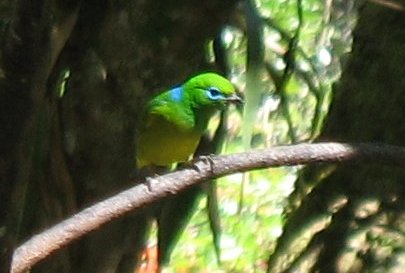
|
|
 |
 |
| It is winter south of the equator, and our room had a fireplace which, of course, Bob had to light. The room became toasty warm in no time. | We had planned to get up to Machu Picchu in time to see the sunrise over the mountains, but with the fire roaring, we decided to stay up late and sit back watching the flames instead. |
|
|
||
|
Lima |
||
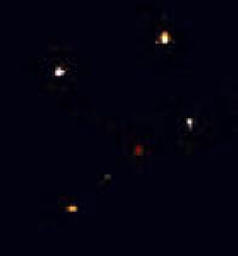 |
On the train to Lima we saw the Southern Cross and the Big Dipper at the same time - we were very close to the equator. It was very weird - the Big Dipper's dipper was below the horizon and the stars were UP SIDE DOWN! In many parts of the world the Big Dipper is called "The Plow." The Southern Cross is made up of four major stars at the top, bottom, left, and right.
On the train to town, a fellow traveler told us
that the bottom most star is called Alpha Centauri. Alpha Centauri is the
closest star to our system - it is actually a trinary system with three
suns. Many science fiction stories focus on Alpha Centauri because of its
close proximity to our solar system. |
|
 |
After spending some time in the Aqua Calientes shopping
area, we caught our train back to Cuzco and spent the night back in the
Libertador Hotel. With an early morning wakeup call we caught a flight
back to Lima and got a tour of the city.
Lima is the capitol of Peru and called the City of the Kings. The main plaza (Plaza Mayor or Plaza de Armas) has a bronze statue dating from 1650. All distances within the Peruvian boarders are measured from this fountain. |
|
|
The Peruvian people are extremely creative in earning money to support
themselves. The advent of tourism has created new job ideas from counting
the number of busses or taxis in one area and relaying the numbers to
independent drivers to acrobatic feats performed in the crosswalks of
major intersections.
But, by far, our favorite example was the little old man with his faithful dog dressed up in a colorful coat, hat, and reading glasses. We took a picture and gave him one Sol (local currency). Everyone loved them. |
 |
|
 |
As a result of decades of earthquakes the Peruvian
people of the past developed amazing building techniques. The major church
had various periods of collapsing and being rebuilt. Eventually the people
decided that building with wood and adobe brick would allow the church the
necessary ability to move and sway when the ground started to shake. The
church pictured at the left is a fine example. There is no stone
supporting the structure.
This church also had catacombs - Amy's favorite tour. The ancient priests decided to sort all the bones into bins throughout the catacombs according to type and size. It was very odd. Even more so, were the circular designs they created with skulls and leg bones inside the wells under the church. |
|
|
The Huaca Pucllana Ruins Dating from the fifth to eighth centuries, the Pre-Incans built this temple in a pyramidal style. They used adobe bricks that were very thin and maybe a foot tall. They were stacked on their edges looking like library books on a shelf with loose mortar between and a layer of adobe between the vertical levels. The construction was earthquake and fire proof. As in many cases, later inhabitants, including present day peoples have destroyed or stolen large areas to suit current needs. |
 |
|
|
|
|
|
|
|
|
Before dinner we took a night time walk (with our guide and the little
bitty flashlight) and after dinner, a night canoe ride.
We could have used a bigger flashlight - or maybe night vision goggles. |
|
 tarantula |
 sleeping snake |
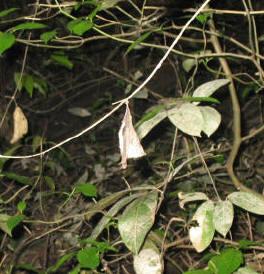 sleeping bat |
 BIG spiders |
 sleeping hummingbird |
 big moth |
 In early morning mists we are on our way to the walkway suspended over the rainforest |
 walking catfish He uses his front fins to walk on land |
 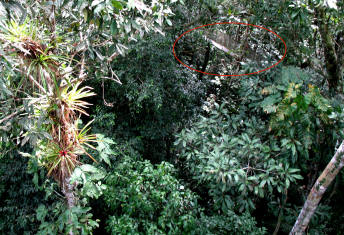 |
| The suspended canopy walkway starts from a platform that is 12 feet high. It weaves between trees to other platforms. The red circle shows another part of walkway. Below, K & K and Bob & Amy are at tree 6, the highest point - 118 feet above the ground. |

 |
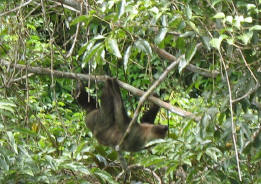
 |
| In the background our guide spotted a two-toed sloth. For a sloth, this guy was practically running. We watched him for a long time precariously going from tree to tree. The final picture is of a black tamarack monkey peeking out from behind a tree. |

 On our way back to the boat, we saw an anteater in a shed. Kini and Kimi crawled up to take a closer look. The anteater seemed to like them. He licked Kimi until she fell over, feet up, then he started on Kini. They will definitely get a bath when get back to Virginia! We also saw a huge and tightly bunched group of brown centipedes clinging to a tree. |

 On this walk we passed the Explornapo lodge where we saw a pygmy monkey and capybara or "water pig". The pygmy monkey was an adult and was about five inches long with a tail that can be eight inches long. It only weighs four to seven ounces. The capybara looks like a medium sized mutt crossed with a rat and a pig ... and has webbed feet like a duck. He is semi-aquatic, a natural herbivore, and the largest living rodent. His name is Charley and he hangs out in this area. |
|
We got back on the boat headed for our lodge and
stopped on the river in an area in which the pink dolphins tend to feed.
Just as we stopped, we saw a huge adult arc out of the water. They are the
strangest of animals. A classic dolphin look, but with a huge forehead and
beautiful pink sides along their upper torso. Unfortunately we didn't get
a picture, but we will never forget the sight. We stayed for a few more
sightings in the deep waters, then we were off to go fishing. |
|
This was the first time Kini and Kimi and Amy went
fishing - and we were fishing for piranha. The bait was cubed beef, which
was just fine with Amy since there wasn't a chance she was going to put a
worm on a hook. Segundo, the guide, was happy with his first catch. He and
the boat driver caught all the fish in the boat. Bob
caught a little white one, but threw it back because of its size. Amy
hooked one of the big red-bellies but the line got caught in the reeds
and the piranha got away. She now has her fish/piranha story; "It was this
big!" Dinner included three cooked piranha - Amy
doesn't eat fish, but Bob said they tasted like fishy chicken. :) Amy got the cooks to keep and clean their jaws to bring home. |

 |
  |

 |
| On our last walk we went to a village that had the look and feel of times past. Some of the women were winding split and dried palm fronds into long strings to make bags and jewelry. The villagers performed some traditional dances where the men used the long poles to beat the ground in rhythm to the eerie flute music. |

 |
 |
|
We then got a demonstration on the use of blowguns. Bob gave it a try and got very close to a bulls-eye. Of course, we brought one home - over 6 feet long with darts, quiver, and a woven sack filled with kapok to wrap around the end flat end of the darts. |
 |

 |
|
The natives use piranha jaw teeth to sharpen the darts. They then make a small score all the way around the tip about one inch down. The scoring allows the tip of the dart to break away and stay in the animal allowing time for the curare to work. |
 |
The villagers were in love with Kini and Kimi. They all got together so we could have our picture taken with them. |
 |
|
|
As our blowgun was a working blowgun, we had to get it wrapped and put it though the checked luggage. Since we were checking one piece, we decided to check our bigger carry on bag too- it only had small gifts and laundry, so why not. Humm... Let us count the ways... 1) the waits and lines to collect and get through three airports and customs, and 2) it never got out of Atlanta. We filed a lost bag claim in Charlotte and a day after we arrived home it was delivered to our doorstep. (The blowgun made it onto all fights.) Amy was rather pleased with the delay - any hitch-hikers, creeping or with wings, would be definitely dead before the zippers were unzipped.
|
After traveling for over 24 hours we finally arrived
home. We enjoyed one pilot's comment as we pushed back, "If your travel plans didn't include a stop in Charlotte, they do now." As usual a big thanks goes out to Mom for keeping
Tai Chi, our dog, stocking our refrigerator, and having a big pot
roast and veggies ready for us for dinner. |
|
|